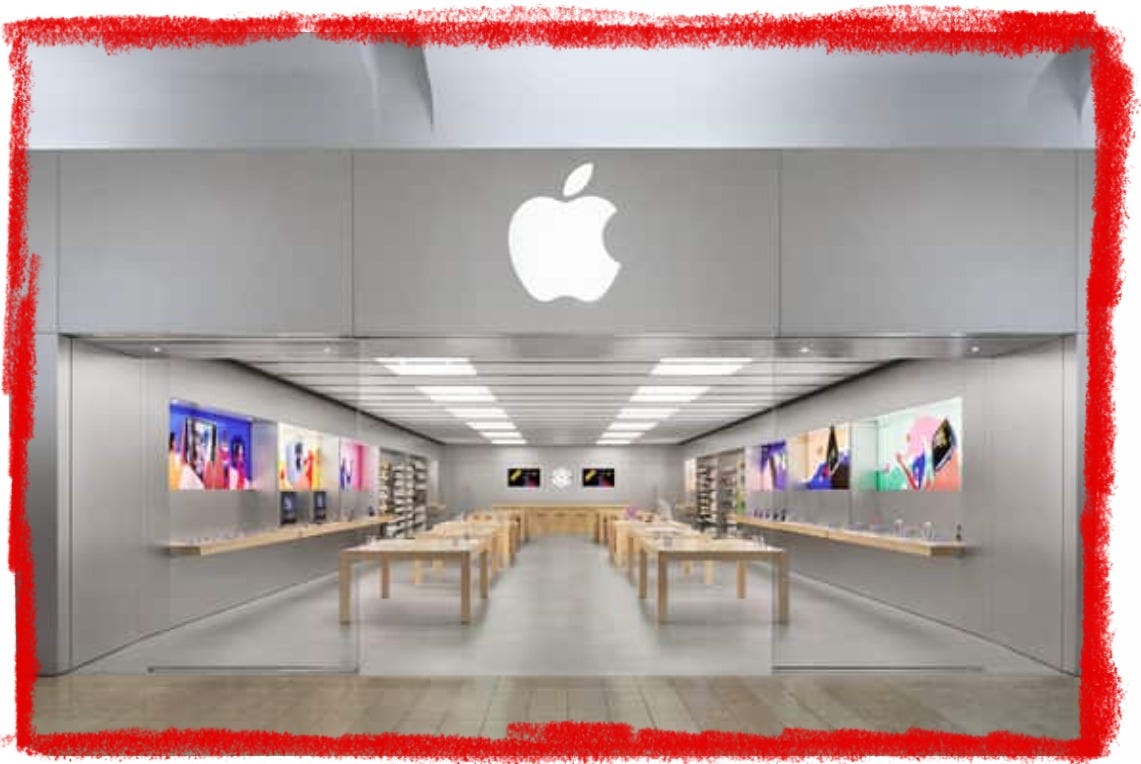Apple Could Never Make Something As Imperfect As This Newsletter
On Individuality, Creativity, and the iPhone's Dubious Story of Origin
Hey friends!
Short newsletter today with some simple thoughts around creativity and individuality. It’s brief, but something I was eager to throw off.
I want to mention that I am so grateful for how many of you have been reading and following along this year. Writing is a high priority for me in 2025 and my hope is to see Prolix grow both in craft and in subscribership. That being said, Substack’s data analytics tells me that a lot more people are reading my posts than are actually following, so… if you have not yet subscribed, you can make me really happy by doing so now! If you are already a subscriber, please consider sending to some friends who might find this work thoughtful. I would be forever grateful!
Steve Jobs Was Afraid Of What?
In Silicon Valley, there is a rumor that Apple cofounder Steve Jobs was beset with a relatively rare but mild form of koumpounophobia — the fear of buttons. According to legend, this phobia is what drove him to don his signature (buttonless) turtleneck and inspired the design of the most iconic product of the last twenty years: the iPhone.
Over 1.3 billion people own an iPhone and the sleek, minimalist aesthetic is one of the primary factors in its mass appeal. For every iPhone sold, Apple has a profit margin of over 50 percent; a premium unheard of in most industries except luxury. Apple enjoys such pricing power because, in terms of branding, they have no equal; and despite their recent losses in the smartphone market, Apple is still the undisputed pioneer of modern style.
As the saying goes, familiarity breeds contempt — and the ubiquitous nature of the iPhone makes it easy to forget that it is, quite literally, a flawless object. The smart device’s incorruptible polish bares no direct trace of human involvement; there are no rough edges, no fingerprints, no seams, and no asymmetries. If not for the tiny Made in China inscription on the back, I have often thought these tiny black mirrors could pass as the mysterious object in the beginning of Stanley Kubrick’s 2001: A Space Odyssey. Like the Monolith of that early sequence, the iPhone seems to transcend the primitive landscape of yesteryear, appearing in our life as though it has always been — and always will be. And like the opening sequence, people go bananas for such alien-like perfection.
The Undiminished Importance of Artists
When I contemplate the iPhone’s design, I can’t help but hear the voice of sculptor Tom Sachs saying:
“I could never make anything as perfect as an Apple product, but Apple could never make something as f**ked up and flawed as one of my sculptures.
Sachs is a New York based artist that has achieved success in commercial circles and in the world of fine art. Everything the bricolage artist makes feels exposed, visceral, and textured. He often subverts the familiar aura of brands by satirizing them with plywood, paint, glue, “blood, sweat, cum, and tears.” The true beauty of his work is in more than just the final appearance, but in the way he leaves evidence of his workmanship as part of the permanent design. By keeping the markings of his process visible, Sachs emphasizes personhood over perfection — a strategic trade-off that gives his work a uniquely creative and human dimension.
The inspiration that Sachs’ work provokes, however, is not necessarily rare. In a time when the authoritarian instinct of politics and Big Tech is constantly impeding on daily life, the vocation of an artist is, perhaps, one of the most recognizable refutations of the emerging social order. An artist’s priorities are incompatible with the priorities of totalitarianism because in order to make, artists must recognize their individuality and adopt a posture of near complete subjectivity. Subjectivity, however, is anathema to the totalitarian, whose only aim is to force conformity and consolidate the masses. Any individual, artist or not, that flourishes and finds joy outside the structures, rhythms, or sanctions of the Machine/State is a force to be reckoned with. His or her existence becomes a clue to the possibility of a simpler, alternative lifestyle — and it is only a matter of time before others are seduced into that same simplicity.
Pursuing Beauty and Diversity
On a practical level, if you find yourself (like many others) overwhelmed with the oppressive atmosphere of the current news cycle or doom-scroll of social media, one of the best practices I can recommend is to set your heart on making something beautiful. Or, at least, making something that you think is beautiful. It’s a challenging process, but I’ve found that orienting yourself toward creation rather than consumption has a reviving effect on one’s humanity. Modern people are not very experienced at shepherding our attention towards the generative, nor are we comfortable with the inwardness, solitude, patience, and frequent stumbling into the walls of our own inconvenient limitations that it requires. Yet, these very limitations are the boundaries in which a sense of unique identity and wholeness can emerge. Don’t let the question of whether or not you are a “creative” hold you back from laying hold of your own individuality. It is your birthright to make.
On a more abstract level, I’ve been musing a lot about the ostensible origin of the iPhone — and I sincerely hope that it did stem from Jobs’ supremely comical weirdness about buttons. If this is the case, it would mean that at the core of the smartphone technology, buried deep beneath anti-repair techniques and algorithmically-driven choice architecture, is an inescapable embrace of individuality and anomaly. It would mean that the smart device, which we so often experience as a tool for homogenization and flattening, is at heart a tribute to the value of imperfection and diversity. If not for Jobs’ unsexy peculiarity, the very sexy device we all know and (sort of) love would never exist. If the story is true, then the iPhone is just another invention, albeit poorly stewarded, that proves incongruencies and individual differences are the irreplaceable engines of innovation, creativity, and wonder. Understanding these differences and giving them room to run wild is one of humanity's truly crowning triumphs — it is the magic that transforms our communities and causes them to prosper. The value of diversity is an iron law that even Apple and its $3.6 trillion market cap cannot break.
Making More Magic
I, for one, am determined to lean harder into this magic in 2025, and I hope to inspire others to do the same. I’ll be showing up to Substack more and more, sharing as much writing, drawings, and photos as I possibly can. To paraphrase Tom Sachs — I will never make anything as perfect as an iPhone, but I do promise to give you something that you can’t find anywhere else. If you’re down for the ride, please hit subscribe and send to a friend!
Curiously yours,
Bradley







